Moisture Migration and Recharge Pattern of Low-Permeability Thick Cohesive Soil in Northern Margin of the Jianghan Plain
Abstract
:1. Introduction
2. Geological Setting
3. Materials and Methods
3.1. Monitoring Systems
3.2. Sampling and Testing
3.2.1. Sampling
- (1)
- Rainfall samples for stable isotopes (D, 18O) testing
- (2)
- Groundwater samples for stable isotopes (D, 18O) testing
- (3)
- Soil moisture samples for stable isotopes (D, 18O) testing
- (4)
- Soil samples for soil volume water content testing
3.2.2. Testing
- (1)
- Stable isotopes value testing
- (2)
- Soil volume water content testing
4. Results and Discussion
4.1. Soil Water—Groundwater Recharge Mode Analysis
4.1.1. Soil Moisture Migration Stratification
4.1.2. Moisture Migration Rules of Thick Cohesive Soil
4.1.3. Vertical Water Movement Conceptual Model of Thick Cohesive Soil
4.2. Numerical Simulation of Precipitation Infiltration in the Field Test Site
4.2.1. Hydrogeological Conceptual Model
4.2.2. Mathematic Model
4.2.3. Initial Conditions and Boundary Conditions
4.2.4. Spatial and Temporal Discretization
4.2.5. Calibration and Validation
4.2.6. Simulation Results
5. Conclusions
- (1)
- The upward movement of the capillary zone roof caused by a rise in the groundwater level can increase the soil volume water content of layers below the depth of 5.0 m. The silty clay layer at the depths from 4.4 m to 5.7 m has a certain retardation effect on the cohesive soil water infiltration, which reduced the soil moisture content’s change in the cohesive soil layer above the depth of 5.0 m caused by groundwater level changes. The soil profile of the field test site could be mainly divided into zones: the sensitive zone of rainfall infiltration (0–1.4 m), the buffer zone of rainfall infiltration (1.4–3.5 m), the migration zone of rainfall infiltration (3.5–5.0 m), and the rainfall infiltration and groundwater level co-influenced zone (5.0–15.0 m). The effects of micro-confined groundwater level dynamic changes were taken into consideration when dividing into zones.
- (2)
- We divided the dynamic change in soil volume water content into a “dehydration period” and a “water absorption period”. Soil layers above the depth of 4.5 m continued infiltrating to lose water from the surface to the bottom in the unsaturated zone during the dehydration period without rainfall. The moisture decrease in the soil layers below 4.5 m started in advance in the 1.4–4.5 m range in the “dehydration period”, affected by a groundwater pressure decrease. The soil moisture begins to infiltrate and migrate downward after reaching a positive water potential gradient, and then soil water continues moving downward through the whole profile gradually, layer by layer. The soil moisture response time of different layers shows a lag from the surface to the bottom in thick cohesive soil. Soil water in the unsaturated zone can infiltrate gradually into the saturated zone and finally recharge the groundwater under multiple rainfalls’ accumulations.
- (3)
- The thick cohesive soil profile in the field test site can be divided into three zones. The first zone, named the shallow mixed zone, was affected by precipitation and evaporation. The depth of its bottom was affected by evaporation, but it was never deeper than 200 cm in any period. The second zone, which had no evaporation, named the steady zone, ranged from the bottom of the shallow mixing zone to the top of the capillary saturation zone. Soil water content was only affected by precipitation infiltration, which caused stable effective recharge to the soil layers below by means of piston flow. The third zone, with only piston flow, named the deep mixing zone, ranged from the top of the capillary saturation zone to 1500 cm and was introduced to form the new conceptual model of the vertical movement of cohesive soil water when taking micro-confined groundwater level dynamic changes into consideration. Soil water above this zone and groundwater recharged together to the deep mixing zone when the groundwater level increased due to rainfall, and the soil water of this zone recharged to the groundwater. This research introduced a new mode as a reference for groundwater recharge studies.
- (4)
- The cumulative water flux at the depth of 200 cm was the effective infiltration recharge from precipitation to soil water in the vadose zone, which can be totally absorbed in cohesive soil and can finally recharge to groundwater. The precipitation infiltration recharge coefficient we obtained through simulation is 0.1389. The cumulative water flux of the cohesive soil layer at the depth of 1100 cm (349 mm) could be considered as the actual recharge from the cohesive soil layer to micro-confined groundwater, which is greater than that of the depth of 200 cm (234 mm). The difference was not only because of a significant lag effect caused by a low saturated permeability coefficient and the long recharge path of the cohesive soil, but also by the exchange capacity, controlled by micro-confined groundwater pressure to a great extent. The exchange capacity decreased as the micro-confined groundwater pressure head increased, leading to a decrease in the rate of the actual recharge of groundwater. On the contrary, the actual recharge of groundwater increased.
- (5)
- The actual recharge to groundwater is the water flux exchange at the roof of the stable saturated zone. The change in the total soil moisture storage in the cohesive soil layers between the layer at the depth of 200 cm and the roof of the stable saturated zone is a non-negligible part and should be taken into consideration when evaluating the recharge of groundwater. Because of the buffering effect of the thick cohesive soil in the field test site, the water amount recharged to the groundwater in wet years was less than that in dry years, in general. On the other hand, although the permeability of thick cohesive soil is low, the recharge coefficient we obtained through the simulation is 0.1389, which means pollutants can infiltrate through soil layers from the surface to cause groundwater pollution. The cumulative effect of multiple rainfalls will accelerate the vertical transport process of water and pollutants in cohesive soil with high water content. In order to prevent groundwater pollution, pollution sources’ control measures should be developed in areas covered with thick cohesive soil.
Author Contributions
Funding
Institutional Review Board Statement
Informed Consent Statement
Data Availability Statement
Conflicts of Interest
References
- GB 16889-2008; MEPC. Standard for Pollution Control on the Landfill Site of Municipal Solid Waste. China Environmental Science Press: Beijing, China, 2008. (In Chinese)
- GB/T 51403-2021; CUCD. Technical Standard for Liner System of Municipal Solid Waste Sanitary Landfill. China Architecture & Building Press: Beijing, China, 2021. (In Chinese)
- Arumdani, I.S.; Budihardjo, M.A.; Syafrudin, S. Landfill Liner Composite Materials: Bibliometric and Content Analysis. Pol. J. Environ. Stud. 2023, 32, 2473–2483. [Google Scholar] [CrossRef]
- Gupt, C.B.; Bordoloi, S.; Sekharan, S. Contaminant Retention Affected by Controlled and Uncontrolled pH for Fly Ash-bentonite Composites Used as Landfill Liner Material. J. Clean. Prod. 2023, 406, 136924. [Google Scholar] [CrossRef]
- Hu, W.; Yu, Y.; Rowe, R.K. Performance of Landfill Low-permeability Liners for Minimizing Groundwater Contamination. Geosynth. Int. 2023; ahead of Print. [Google Scholar] [CrossRef]
- Li, Q.; Chen, J.N.; Benson, C.H.; Peng, D.P. Hydraulic Conductivity of Bentonite-polymer Composite Geosynthetic Clay Liners Permeated with Bauxite Liquor. Geotext. Geomembr. 2021, 49, 420–429. [Google Scholar] [CrossRef]
- Li, J.H.; Li, L.; Chen, R.; Li, D.Q. Cracking and Vertical Preferential Flow through Landfill Clay Liners. Eng. Geol. 2016, 206, 33–41. [Google Scholar] [CrossRef]
- Yang, L.B.; Li, L.; Liu, Y.Q.; Dong, L.; Zhao, N.N. Comparative Research on Standard for Leakage Prevention Structures of Landfills Sites for Domestic Wastes in Various Countries. Environ. Eng. 2007, 25, 4–5, (In Chinese with English Abstract). [Google Scholar]
- Xu, S.F.; Yan, Y. Use of Impermeable Materials for Refuse Landfills in Japan. Environ. Eng. 2006, 24, 68–70+5, (In Chinese with English Abstract). [Google Scholar]
- David, E.D. Clay Liners. In Geotechnical Practice for Waste Disposal, 1st ed.; Springer-Science+Business Media, B.V.: London, UK, 1993; Part Two; pp. 137–163. [Google Scholar]
- Han, D.M.; Currel, M.J.; Guo, H.M. Controls on Distributions of Sulphate, Fluoride, and Salinity in Aquitard Porewater from the North China Plain: Long-term Implications for Groundwater Quality. J. Hydrol. 2021, 603, 126828. [Google Scholar] [CrossRef]
- Liu, T.W.; Hu, C.; Wang, Q.; Li, J.; Huang, K.; Chen, Z.H.; Shi, T.T. Conversion Relationship of Rainfall-Soil moisture-Groundwater in Quaternary Thick Cohesive Soil in Jianghan Plain, Hubei Province, China. China Geol. 2020, 3, 462–472. [Google Scholar]
- Liu, T.W.; Pan, Y.; Hu, C.; Wang, Q.; Chen, Z.H.; Shi, T.T. Tracing Infiltration and Recharge of Thick Silt by Using D, 18O Isotopes of Soil Moisture in Xiaogan, Hubei and Its Ecological Effects. Geol. China 2021, 48, 1429–1440, (In Chinese with English Abstract). [Google Scholar]
- Luo, Z.B.; Fan, J.; Shao, M.A.; Hu, W.; Yang, Q.; Zhang, S.G. Soil Water Dynamics and Groundwater Evolutions of Check Dams under Natural Rainfall Reduction in Semi-arid Areas. J. Hydrol. 2023, 617, 129099. [Google Scholar] [CrossRef]
- Wang, C.X.; Li, T.L.; Li, P.; Wang, Y.; Li, H.; Xi, Y. Verification on the Mode of Moisture Transfer in the Vadose Zone of Thick Loess. Hydrol. Process. 2022, 36, e14656. [Google Scholar] [CrossRef]
- Dong, R.; He, Y.J. Numerical Simulation of Hydraulic Properties of Soil in the GSPAC System under Variable Water-levels. Earth Sci. Inform. 2021, 14, 831–835. [Google Scholar] [CrossRef]
- Du, K.; Zhang, B.Y.; Li, L.J. Soil Water Dynamics Under Different Land Uses in Loess Hilly Region in China by Stable Isotopic Tracing. Water 2021, 13, 242. [Google Scholar] [CrossRef]
- Li, Y.T.; Yu, Y.; Sun, R.X.; Shen, M.S.; Zhang, J.J. Simulation of Soil Water Dynamics in a Black Locust Plantation on the Loess Plateau, Western Shanxi Province, China. Water 2021, 13, 1213. [Google Scholar] [CrossRef]
- Li, X.; Lu, Y.D.; Zhang, X.Z.; Zhang, R.; Fan, W.; Pan, W.W. Influencing Factors of the Spatial–Temporal Variation of Layered Soils and Sediments Moistures and Infiltration Characteristics under Irrigation in a Desert Oasis by Deterministic Spatial Interpolation Methods. Water 2019, 11, 1483. [Google Scholar] [CrossRef]
- Zhang, J.X.; Wang, X.; Xu, D.; Cai, J.B.; Lv, W.; Tang, Y.; Na, W.J. Experimental Study on Moisture Recovery of Dried Soil under Natural Precipitation Condition. Trans. Chin. Soc. Agric. Eng. 2021, 37, 159–166, (In Chinese with English Abstract). [Google Scholar]
- Zhang, J.X.; Wang, X.; Wang, Y.K.; Jin, S.S.; Dong, J.G.; Wang, Z.T. Regularities of Rainfall Infiltration and Water Migration in Woodland Drying Soil in the Loess Hilly Region. J. Soil Water Conserv. 2017, 31, 231–238, (In Chinese with English Abstract). [Google Scholar] [CrossRef]
- Lu, P.R.; Sheng, Z.P.; Zhang, Z.Y.; Miller, G.; Reinert, S.; Haung, M.Y. Effect of Multilayered Groundwater Mounds on Water Dynamics Beneath A Recharge Basin: Numerical Simulation and Assessment of Surface Injection. Hydrol. Process. 2021, 35, e14193. [Google Scholar] [CrossRef]
- Hou, X.K.; Vanapalli, S.K.; Li, T.L. Water Flow in Unsaturated Soils Subjected to Multiple Infiltration Events. Can. Geotech. J. 2020, 57, 366–376. [Google Scholar] [CrossRef]
- Xie, J.Y.; Sun, F.Q.; Zou, L.R.; Qi, J.H. Hydrogen and Oxygen Isotope Signatures of Soil Water in the Thick Unsaturated Zone and the Source Identification. Earth Environ. 2020, 48, 728–735, (In Chinese with English Abstract). [Google Scholar] [CrossRef]
- Zhao, M.; Wang, W.K.; Wang, Z.F.; Chen, L.; Ma, Z.T.; Wang, Q.M. Water Use of Salix in the Variably Unsaturated Zone of A Semiarid Desert Region Based on In-situ Observation. J. Hydrol. 2020, 591, 125579. [Google Scholar] [CrossRef]
- Xu, Y.D.; Wang, J.K.; Gao, X.D.; Zhang, Y.L. Application of Hydrogen and Oxygen Stable Isotope Techniques on Soil Water Research: A Review. J. Soil Water Conserv. 2018, 32, 1–9+15, (In Chinese with English Abstract). [Google Scholar] [CrossRef]
- Bai, S.Y.; Wang, Y.K.; Ma, J.P.; Wang, X.; Zhou, Y.H. Experimental Study on Rainfall Infiltration in Semiarid Region of the Loess Plateau. Agric. Res. Arid. Areas 2016, 34, 218–223+231, (In Chinese with English Abstract). [Google Scholar] [CrossRef]
- Huo, S.Y.; Jin, M.G.; Liang, X.; Lin, D. Changes of Vertical Groundwater Recharge with Increase in Thickness of Vadose Zone Simulated by One-Dimensional Variably Saturated Flow Model. J. Earth Sci. 2014, 25, 1043–1050. [Google Scholar] [CrossRef]
- Chang, W.; Huang, K.; Hu, C.; Wang, Q.; Wang, N.T. Characteristics of the Aquifer Structure and Groundwater Conversion Model in the Northeastern Yunying Basin. Hydrogeol. Eng. Geol. 2019, 46, 9–15+23, (In Chinese with English Abstract). [Google Scholar] [CrossRef]
- Tao, G.; Huang, Z.; Xiao, H.; Zhao, W.; Luo, Q. A New Nonlinear Seepage Model for Clay Soil Considering the Initial Hydraulic Gradient of Microscopic Seepage Channels. Comput. Geotech. 2023, 154, 105179. [Google Scholar] [CrossRef]
- Wang, S.W.; Lu, B.B.; Zhu, W. Effect of Minerals on the Threshold of Compacted Clay Material Liners and Service Life of Barriers in Municipal Solid Waste Landfills. Acta Geotech. 2023, 18, 1025–1037. [Google Scholar] [CrossRef]
- Xu, Y.L.; Du, C.Y.; Ma, H.Z.; Pang, W.; Huang, S.H.; Li, S.M. Experimental and Theoretical Explanations for the Initial Difference in the Hydraulic Head in Aquitards. Water 2022, 14, 3042. [Google Scholar] [CrossRef]
- Feng, W. Seepage in Cohesive Soil Layer of the Impounded Region of Ni’erji Reservoir. J. Eng. Geol. 2010, 18, 64–70, (In Chinese with English Abstract). [Google Scholar]
- Rosenberg, L.; Mosthaf, K.; Broholm, M.M.; FjordbØge, A.S.; Tuxen, N.; Kerrn-Jespersen, I.H.; RØnde, V.; Bjerg, P.L. A Novel Concept for Estimating the Contaminant Mass Discharge of Chlorinated Ethenes Emanating from Clay Till Sites. J. Contam. Hydrol. 2023, 252, 104121. [Google Scholar] [CrossRef]
- Huang, T.; Ma, B.; Pang, Z.; Li, Z.; Li, Z.B.; Long, Y. How Does Precipitation Recharge Groundwater in Loess Aquifers? Evidence from Multiple Environmental Tracers. J. Hydrol. 2020, 583, 124532. [Google Scholar] [CrossRef]
- Qi, D.H.; Jin, M.G.; Liu, Y.F. Determination of Preferential Flow in Precipitation Infiltration Recharge. Earth Sci. 2007, 32, 420–424, (In Chinese with English Abstract). [Google Scholar]
- Chen, P.Y.; Ma, J.Z.; Ma, X.Y.; Yu, Q.; Cui, X.K.; Guo, J.B. Groundwater Recharge in Typical Geomorphic Landscapes and Different Land Use Types on the Loess Plateau, China. Hydrol. Process. 2023, 37, e14860. [Google Scholar] [CrossRef]
- Su, C.; Chen, Z.Y.; Chen, J.; Fei, Y.H.; Chen, J.J.; Duan, B.Q. Mechanics of Aquitard Drainage by Aquifer-System Compaction and Its Implications for Water-Management in the North China Plain. J. Earth Sci. 2014, 25, 598–604. [Google Scholar] [CrossRef]
- Cao, W.B. Water Release of Cohesive Soil in Pore Confined Aquifer System and Its Significance in Resource Evaluation. Hydrogeol. Eng. Geol. 1983, 4, 8–13. (In Chinese) [Google Scholar] [CrossRef]
- Ma, B.; Liang, X.; Liu, S.H.; Jin, M.G.; Nimmo, J.R.; Li, J. Evaluation of Diffuse and Preferential Flow Pathways of Infiltrated Precipitation and Irrigation Using Oxygen and Hydrogen Isotopes. Hydrogeol. J. 2017, 25, 675–688. [Google Scholar] [CrossRef]
- Berthelin, R.; Olarinoye, T.; Rinderer, M.; Mudarra, M.; Demand, D.; Scheller, M.; Hartmann, A. Estimating Karst Groundwater Recharge from Soil Moisture Observations—A New Method Tested at the Swabian Alb, Southwest Germany. Hydrol. Earth Syst. Sci. 2023, 27, 385–400. [Google Scholar] [CrossRef]
- Hu, H.Y.; Bao, W.M.; Wang, T.; Zhai, S.M. Simulation and Experiment on Variations of Hydrogen and Oxygen Isotopes in Soil Water. Water Resour. Power 2008, 04, 149–152, (In Chinese with English Abstract). [Google Scholar]
- Wang, T.; Bao, W.M.; Chen, X.; Shi, Z.; Hu, H.Y.; Zhai, S.M. Soil Water Extraction Using Vacuum Distillation Technology. J. Hohai Univ. (Nat. Sci.) 2009, 37, 660–664, (In Chinese with English Abstract). [Google Scholar]
- Yuan, R.Q.; Song, X.F.; Han, D.M.; Zhang, Y.H.; Zhang, L.; Zhang, B.; Long, X.T.; Yu, Y.L. Rate and Historical Change of Direct Recharge from Precipitation Constrained by Unsaturated Zone Profiles of Chloride and Oxygen-18 in Dry River Bed of North China Plain. Hydrol. Process. 2012, 26, 1291–1301. [Google Scholar] [CrossRef]
- Evaristo, J.; Jasechko, S.; McDonnell, J.J. Global Separation of Plant Transpiration from Groundwater and Streamflow. Nature 2015, 525, 91–94. [Google Scholar] [CrossRef] [PubMed]
- China Geological Survey. Handbook of Hydrogeology, 2nd ed.; Geology Press: Beijing, China, 2012; pp. 683–684. (In Chinese) [Google Scholar]
- Tan, X.C.; Yang, J.Z.; Song, X.H.; Zha, Y.Y. Estimation of Groundwater Recharge in North China Plain. Adv. Water Sci. 2013, 24, 73–81. [Google Scholar] [CrossRef]
- Lu, X.H.; Jin, M.G.; Van Genuchten, M.T.; Wang, B.G. Groundwater Recharge at Five Representative Sites in Hebei Plain, China. Ground Water 2011, 49, 286–294. [Google Scholar] [CrossRef] [PubMed]
- Wang, B.G. Research on Estimating Methods of Groundwater Recharge: A Case in North China Plain. Ph.D. Thesis, China University of Geosciences, Wuhan, China, May 2018. (In Chinese). [Google Scholar]
- Huo, S.Y.; Jin, M.G. Effects of Precipitation and Irrigation on Vertical Groundwater Recharge. Hydrogeol. Eng. Geol. 2015, 42, 6–13+21, (In Chinese with English Abstract). [Google Scholar]
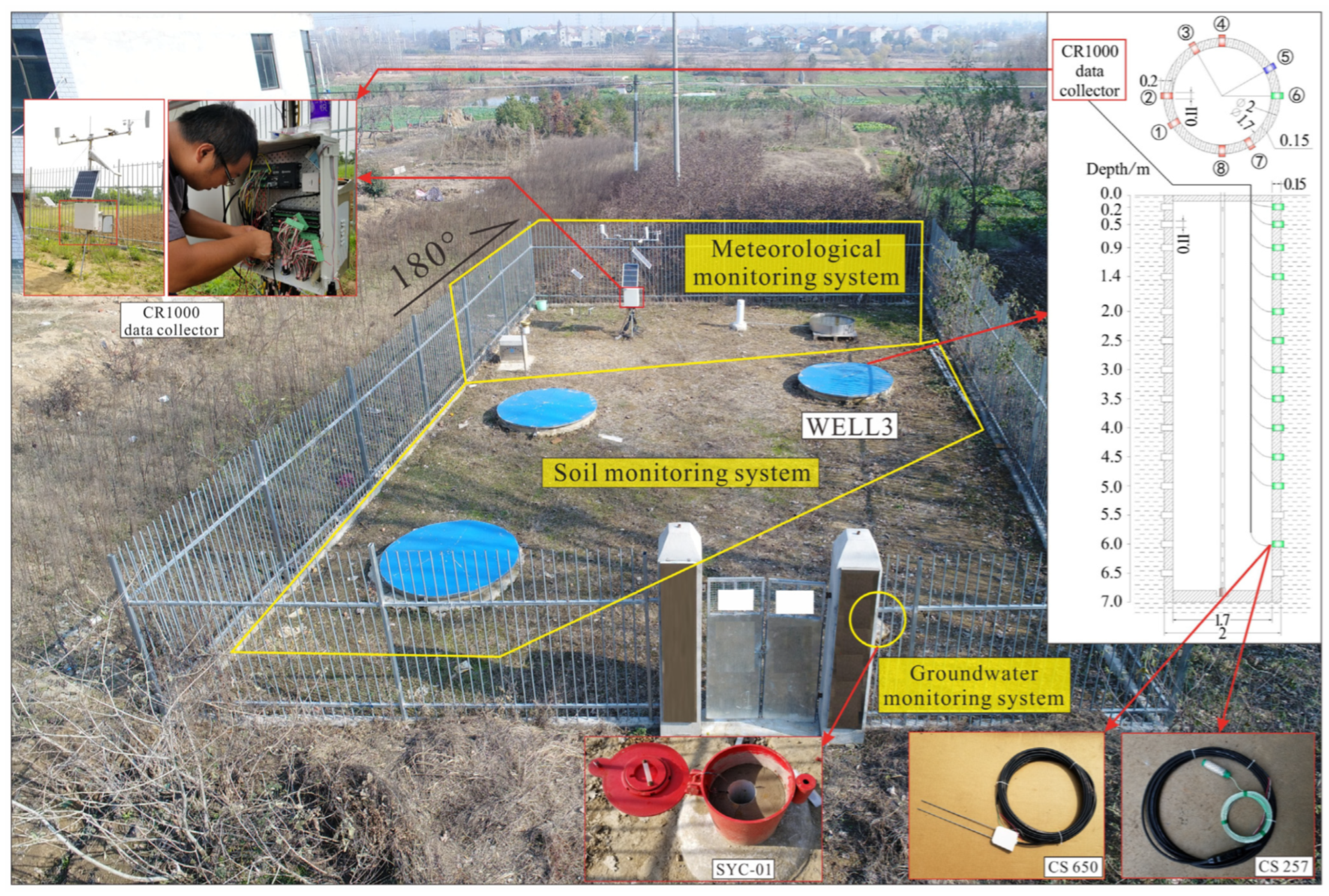
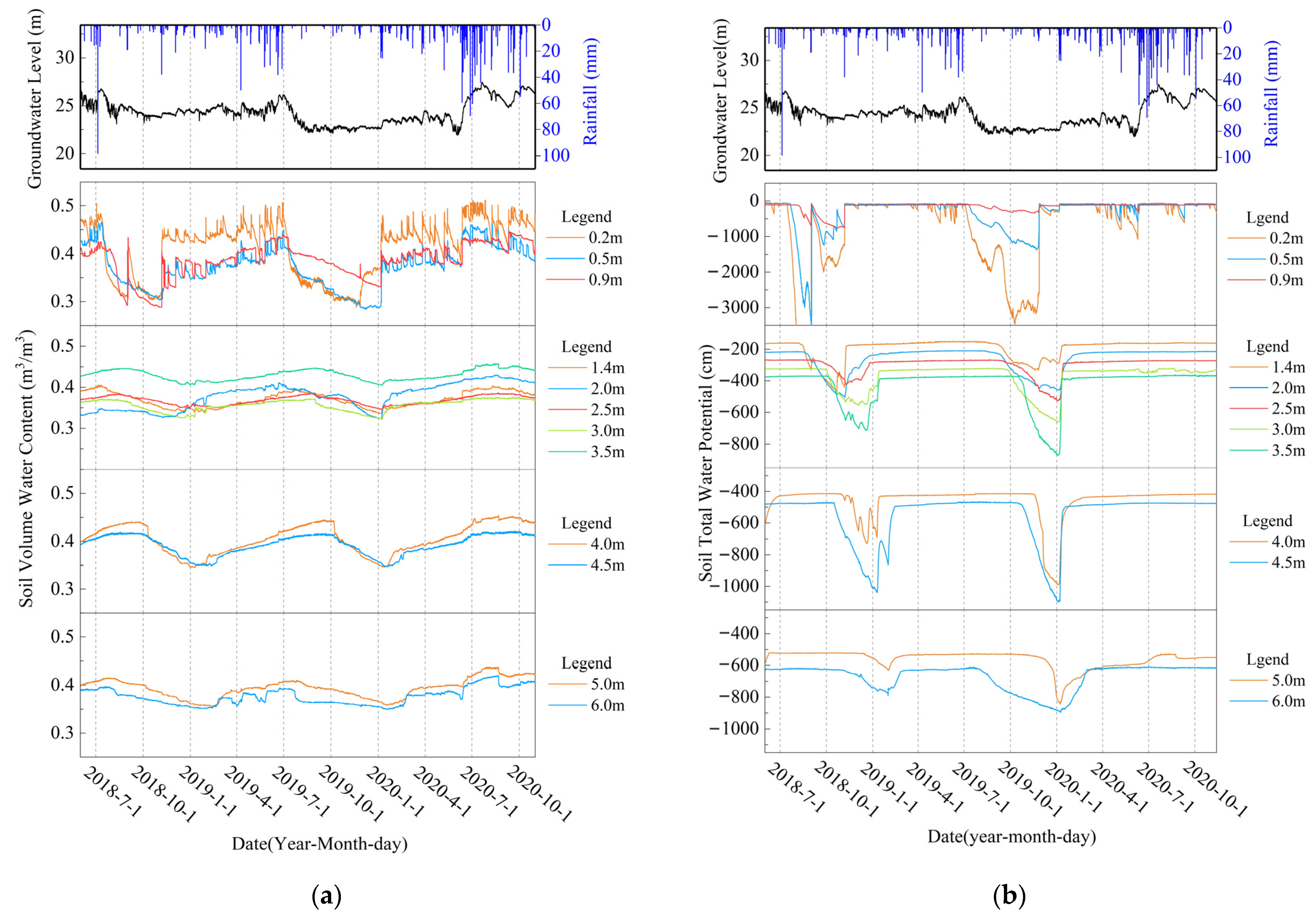

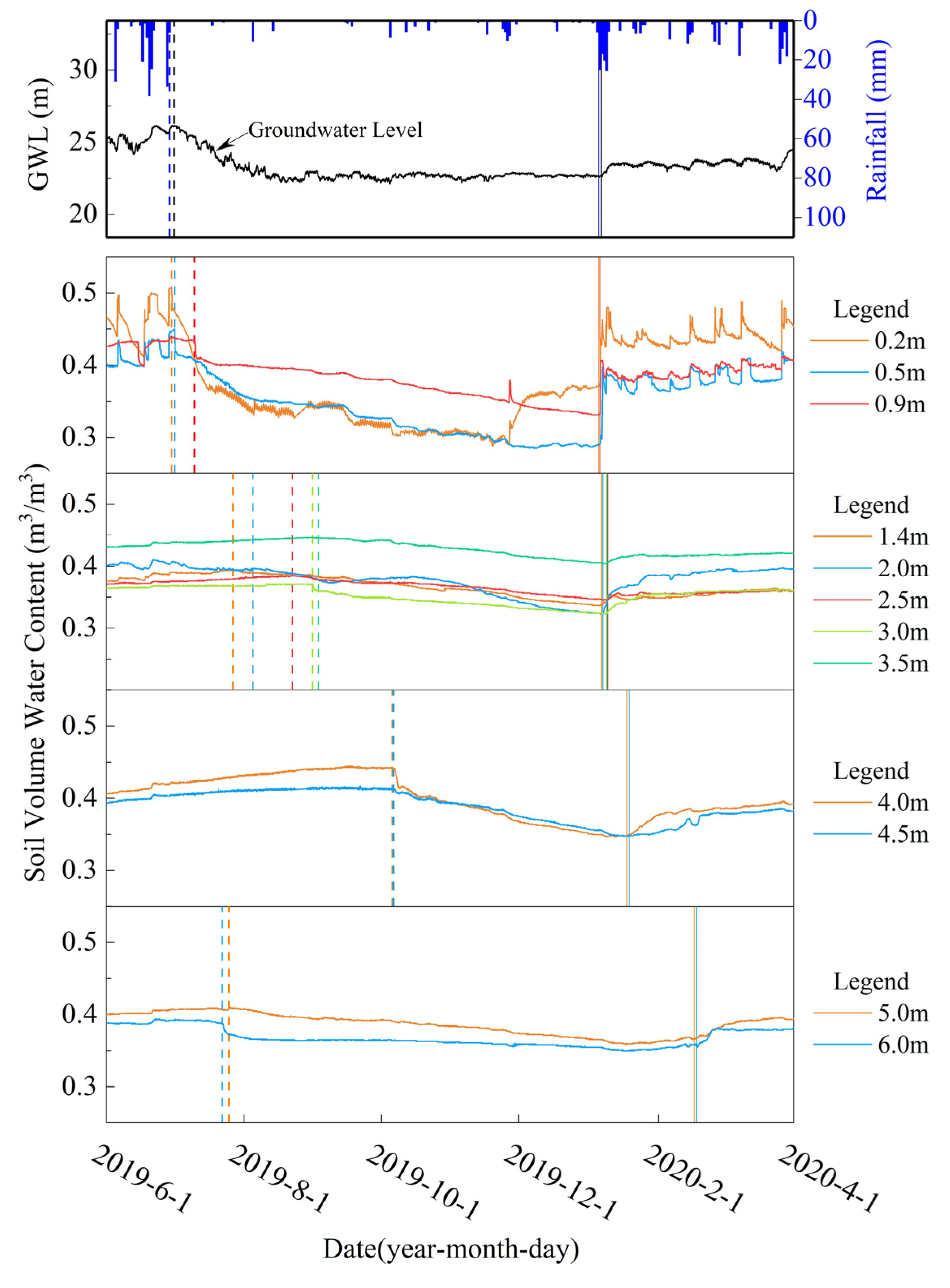
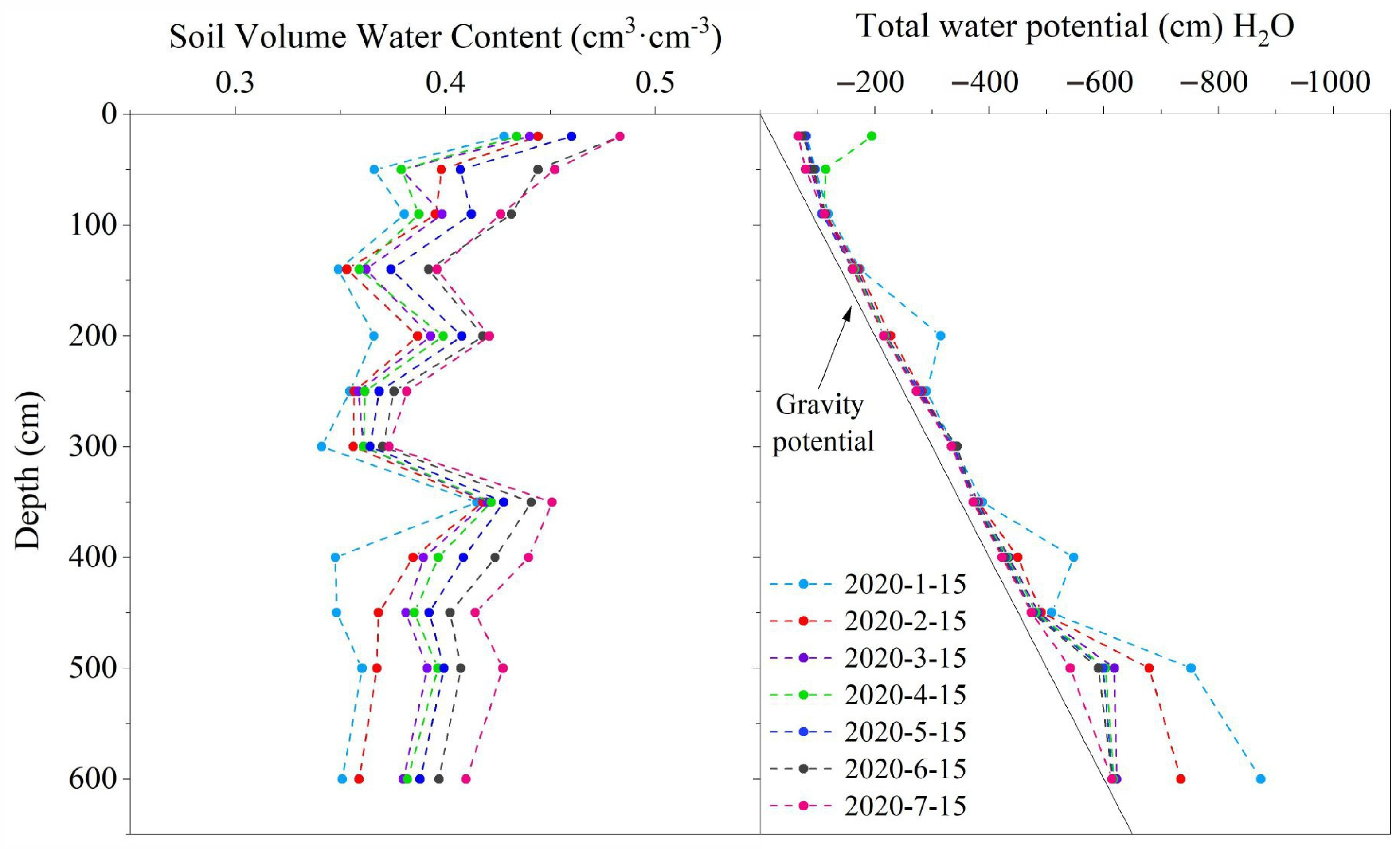


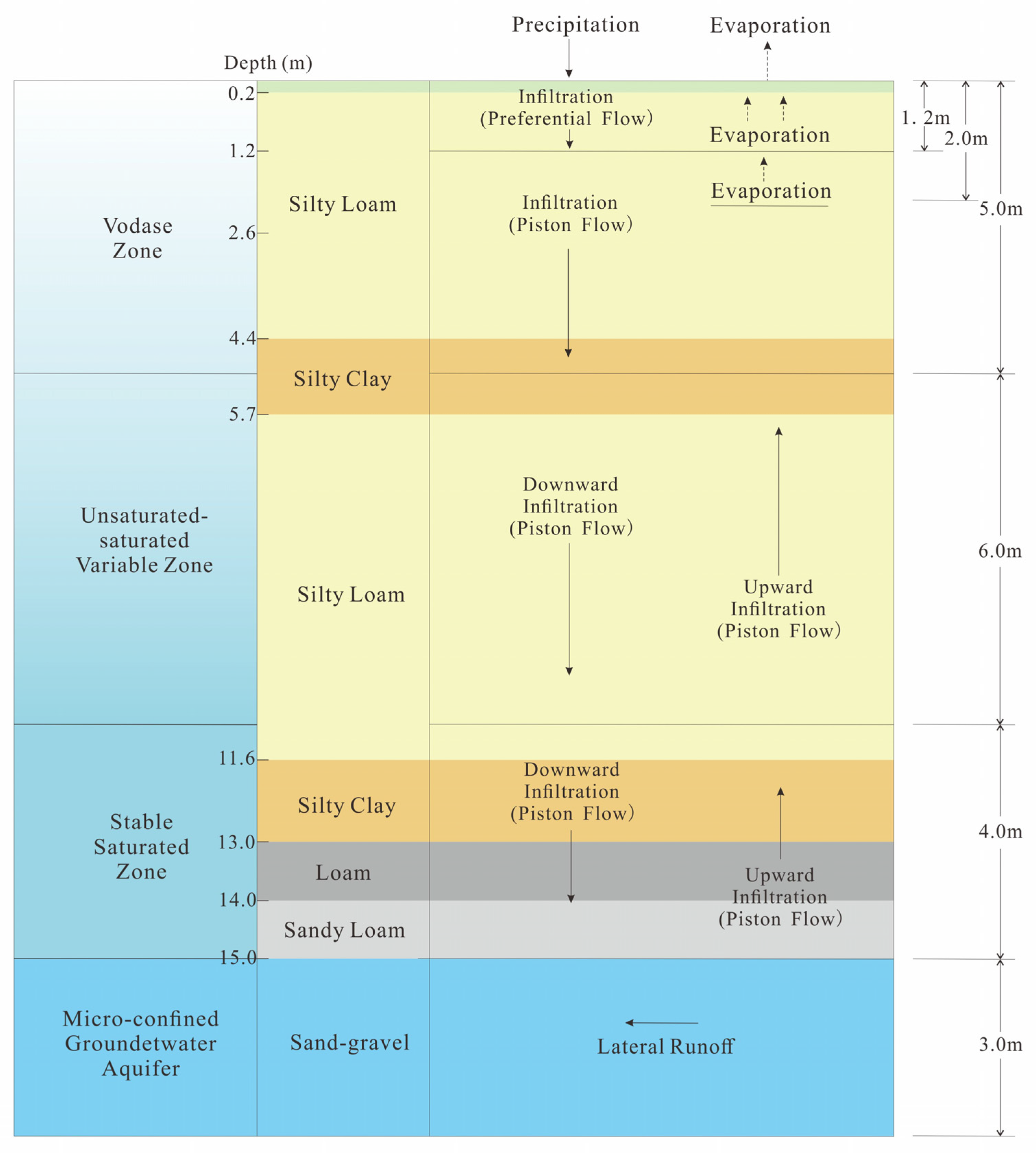
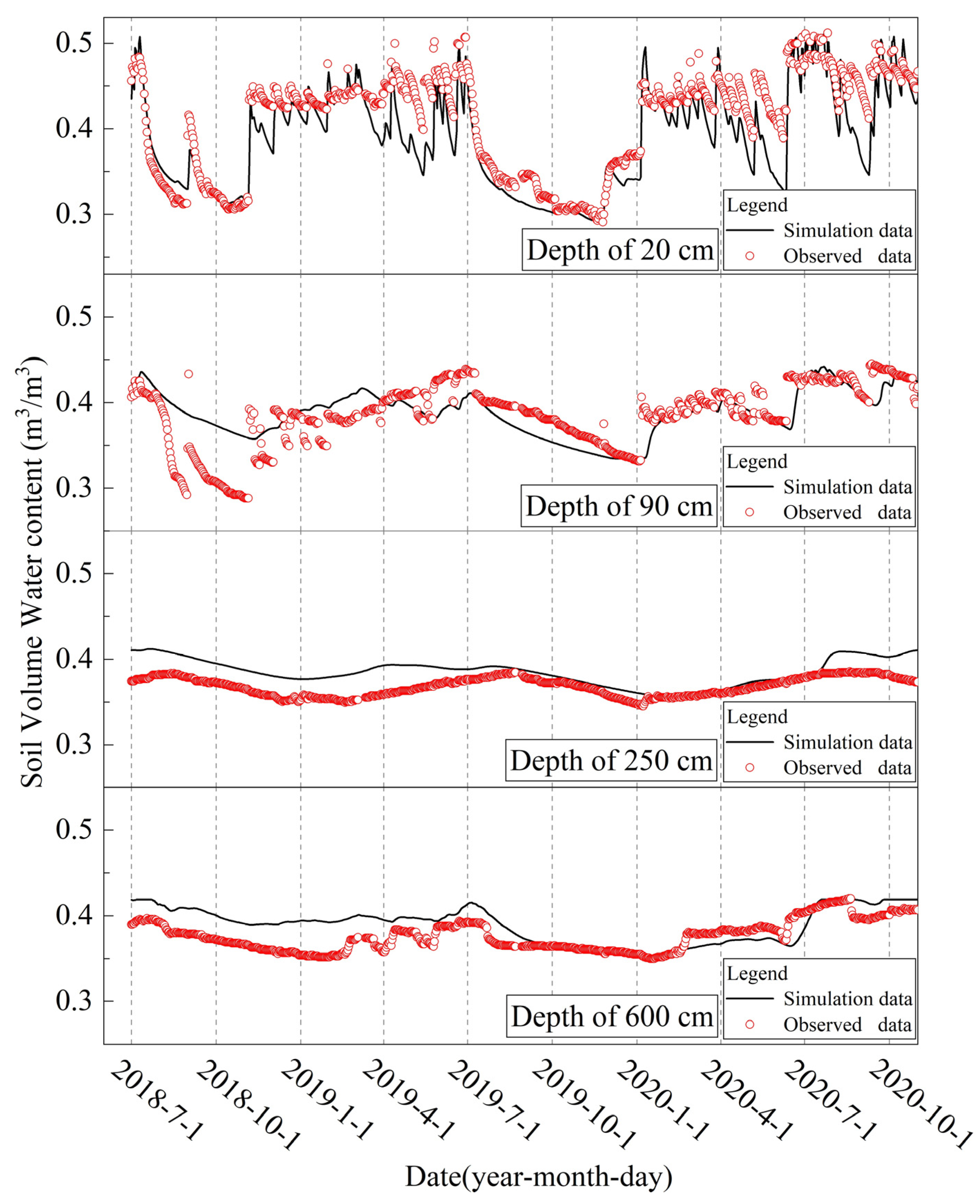
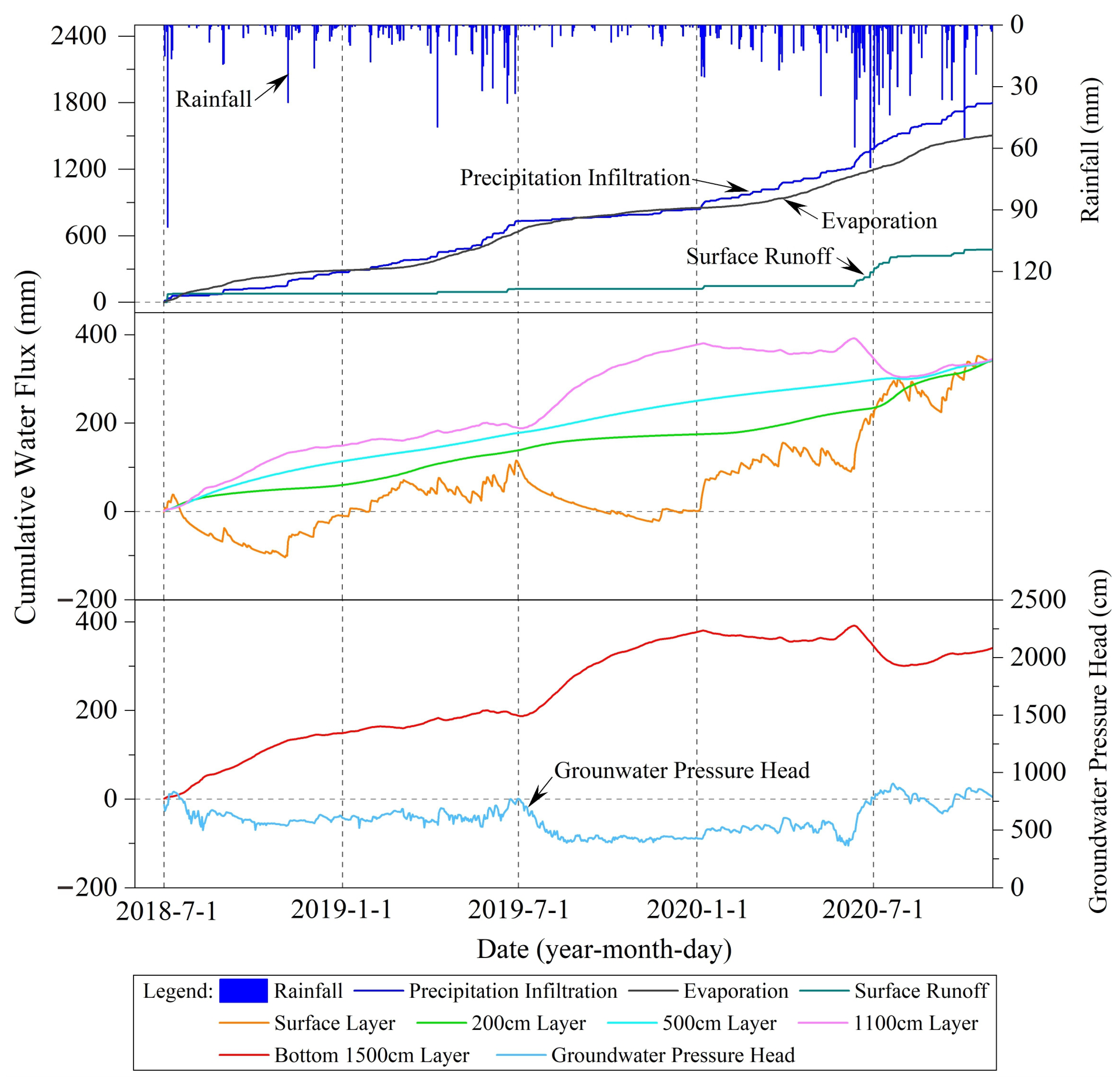
| Stratum Symbol | Depth (m) | Elevation (m) | Sand (%) | Silt (%) | Clay (%) | Soil Texture (lithology) | Bulk Density (g/cm3) | Hydraulic Conductivity (K) (cm/s) | Permeability |
|---|---|---|---|---|---|---|---|---|---|
| Qp3al | 0–0.20 | 33.20 | 10.40 | 67.60 | 22.00 | Silty loam | 1.49 | 10−7–10−5 | Extremely low—weak |
| 0.20–1.20 | 32.20 | 12.13 | 71.62 | 16.25 | 1.51 | ||||
| 1.20–2.60 | 30.80 | 8.90 | 74.17 | 16.90 | 1.48 | ||||
| 2.60–4.40 | 29.00 | 0.93 | 72.44 | 26.63 | 1.60 | ||||
| 4.40–5.70 | 27.70 | 1.20 | 62.15 | 36.65 | Silty clay | 1.66 | |||
| 5.70–11.60 | 21.80 | 3.00 | 79.42 | 17.58 | Silty loam | 1.63 | |||
| 11.60–13.00 | 20.40 | 4.60 | 61.49 | 33.91 | Silty clay | 1.41 | |||
| 13.00–14.00 | 19.40 | 45.10 | 41.54 | 13.36 | Loam | 1.67 | \ \ | \ | |
| 14.00–15.00 | 18.40 | 66.17 | 26.43 | 7.40 | Sandy loam | \ | \ | ||
| 15.00–18.00 | 15.40 | \ | \ | \ | Sand-gravel | \ | 1.3 × 10−2 | Strong |
| System | Equipment Model | Factor | Company | Frequency |
|---|---|---|---|---|
| Soil monitoring system | CS650 | Volume water content | Campbell Scientific Co., Ltd. Logan, UT, USA. | Every 10 min |
| CS257 | Soil water potential | |||
| HFP01 | Surface heat flux | |||
| Meteorological monitoring system | 034B | Wind speed and direction | ||
| HMP155A | Humidity, air temperature | |||
| TE525MM | Rainfall | |||
| CS100 | Atmospheric pressure | |||
| CRN4 | Net solar radiation | |||
| 255–100 | Evaporation | |||
| Groundwater monitoring system | Levelogger III 3001 | Groundwater level | Solinst Canada Ltd. Georgetown, ON, Canada. |
| Parameters | Water Absorption Period and Dehydration Period Transition Time | Lag Time | Dehydration Period and Water Absorption Period Transition Time | Lag Time | |
|---|---|---|---|---|---|
| Rainfall end time | 29 June 2019 09:00 | \ | 5 January 2020 08:00 | \ | |
| Soil layer depth (m) | 0.2 | 30 June 2019 00:00 | 15 h | 5 January 2020 10:00 | 2 h |
| 0.5 | 1 July 2019 06:00 | 1 d 21 h * | 6 January 2020 03:00 | 19 h | |
| 0.9 | 10 July 2019 01:00 | 10 d 16 h | 6 January 2020 03:00 | 19 h | |
| 1.4 | 27 July 2019 05:00 | 27 d 20 h | 6 January 2020 19:00 | 1 d 11 h | |
| 2.0 | 5 August 2019 05:00 | 36 d 20 h | 7 January 2020 06:00 | 1 d 22 h | |
| 2.5 | 22 August 2019 13:00 | 54 d 4 h | 9 January 2020 11:00 | 4 d 3 h | |
| 3.0 | 31 August 2019 10:00 | 63 d 1 h | 8 January 2020 23:00 | 3 d 15 h | |
| 3.5 | 3 September 2019 04:00 | 65 d 19 h | 9 January 2020 03:00 | 3 d 19 h | |
| 4.0 | 5 October 2019 20:00 | 98 d 11 h | 18 January 2020 01:00 | 12 d 17 h | |
| 4.5 | 6 October 2019 11:00 | 99 d 2 h | 19 January 2020 00:00 | 13 d 16 h | |
| 5.0 | 25 July 2019 14:00 | 26 d 5 h | 16 February 2020 21:00 | 42 d 13 h | |
| 6.0 | 22 July 2019 09:00 | 23 d | 18 February 2020 06:00 | 43 d 22 h | |
| GWL response time | 1 July 2019 00:00 | 1 d 15 h | 6 January 2020 17:00 | 1 d 9 h | |
| Layer | Depth (cm) | θr (m3/m3) | θs (m3/m3) | α (1/cm) | n | Ks (cm/d) | l |
|---|---|---|---|---|---|---|---|
| 1 | 0~20 | 0.0514 | 0.4005 | 0.0065 | 1.6332 | 30.36 | 0.5 |
| 2 | 20~120 | 0.0483 | 0.3902 | 0.0069 | 1.6226 | 30.85 | 0.5 |
| 3 | 120~260 | 0.0511 | 0.4071 | 0.0067 | 1.6326 | 33.02 | 0.5 |
| 4 | 260~440 | 0.0561 | 0.4089 | 0.0076 | 1.5748 | 11.73 | 0.5 |
| 5 | 440~570 | 0.0568 | 0.3949 | 0.0077 | 1.5469 | 8.05 | 0.5 |
| 6 | 570~1160 | 0.0496 | 0.3948 | 0.0085 | 1.5626 | 14.75 | 0.5 |
| 7 | 1160~1300 | 0.0654 | 0.4407 | 0.0057 | 1.6512 | 24.33 | 0.5 |
| 8 | 1300~1400 | 0.0283 | 0.3071 | 0.0249 | 1.3592 | 18.57 | 0.5 |
| 9 | 1400~1500 | 0.0280 | 0.4010 | 0.0364 | 1.4277 | 74.82 | 0.5 |
| Depth (m) | (m3/m3) | (m3/m3) | |Oi − Pi|max | MAE | RSME | |
|---|---|---|---|---|---|---|
| 0.2 | 0.4096 | 0.3902 | 0.0194 | 0.1167 | 0.0251 | 0.0333 |
| 0.9 | 0.3854 | 0.3877 | 0.0023 | 0.0946 | 0.0216 | 0.0296 |
| 2.5 | 0.3682 | 0.3854 | 0.0163 | 0.0372 | 0.0166 | 0.0197 |
| 6.0 | 0.3764 | 0.3887 | 0.0123 | 0.0421 | 0.0176 | 0.0213 |
| Layer | Depth (cm) | θr (m3/m3) | θs (m3/m3) | α (1/cm) | n | Ks (cm/d) | l |
|---|---|---|---|---|---|---|---|
| 1 | 0~20 | 0.1014 | 0.511 | 0.0035 | 1.7632 | 0.2239 | 0.5 |
| 2 | 20~120 | 0.0783 | 0.445 | 0.0024 | 2.3556 | 0.2217 | 0.5 |
| 3 | 120~260 | 0.1001 | 0.417 | 0.0029 | 2.3726 | 0.2476 | 0.5 |
| 4 | 260~440 | 0.1101 | 0.456 | 0.0026 | 1.2548 | 0.7377 | 0.5 |
| 5 | 440~570 | 0.1068 | 0.439 | 0.0024 | 1.2869 | 0.3011 | 0.5 |
| 6 | 570~1160 | 0.0696 | 0.419 | 0.0025 | 1.8826 | 1.3439 | 0.5 |
| 7 | 1160~1300 | 0.1054 | 0.441 | 0.0021 | 1.3612 | 0.7535 | 0.5 |
| 8 | 1300~1400 | 0.0483 | 0.387 | 0.0249 | 1.3592 | 4.8774 | 0.5 |
| 9 | 1400~1500 | 0.0283 | 0.401 | 0.0364 | 1.4277 | 12.8226 | 0.5 |
| Reference | Location | Method | Recharge Coefficient |
|---|---|---|---|
| Handbook of Hydrogeology [46] | Anhui | \ | 0.10–0.15 |
| Tan et al. [47] | North China Plain | Bromine tracer | 0.14 |
| Lu et al. [48] | Hengshui | Hydrus 1D | 0.19 |
| Wang [49] | Luancheng | Bromine and 3H tracer | 0.20 |
| Huo et al. [50] | Hengshui | Hydrus 1D | 0.13 |
| This article | Jianghan Plain | Hydrus 1D | 0.1389 |
Disclaimer/Publisher’s Note: The statements, opinions and data contained in all publications are solely those of the individual author(s) and contributor(s) and not of MDPI and/or the editor(s). MDPI and/or the editor(s) disclaim responsibility for any injury to people or property resulting from any ideas, methods, instructions or products referred to in the content. |
© 2023 by the authors. Licensee MDPI, Basel, Switzerland. This article is an open access article distributed under the terms and conditions of the Creative Commons Attribution (CC BY) license (https://creativecommons.org/licenses/by/4.0/).
Share and Cite
Liu, T.; Wang, N.; Hu, C.; Wang, Q.; Huang, K.; Chen, Z.; Shi, T. Moisture Migration and Recharge Pattern of Low-Permeability Thick Cohesive Soil in Northern Margin of the Jianghan Plain. Appl. Sci. 2023, 13, 12720. https://doi.org/10.3390/app132312720
Liu T, Wang N, Hu C, Wang Q, Huang K, Chen Z, Shi T. Moisture Migration and Recharge Pattern of Low-Permeability Thick Cohesive Soil in Northern Margin of the Jianghan Plain. Applied Sciences. 2023; 13(23):12720. https://doi.org/10.3390/app132312720
Chicago/Turabian StyleLiu, Tianwen, Ningtao Wang, Cheng Hu, Qing Wang, Kun Huang, Zhihua Chen, and Tingting Shi. 2023. "Moisture Migration and Recharge Pattern of Low-Permeability Thick Cohesive Soil in Northern Margin of the Jianghan Plain" Applied Sciences 13, no. 23: 12720. https://doi.org/10.3390/app132312720
APA StyleLiu, T., Wang, N., Hu, C., Wang, Q., Huang, K., Chen, Z., & Shi, T. (2023). Moisture Migration and Recharge Pattern of Low-Permeability Thick Cohesive Soil in Northern Margin of the Jianghan Plain. Applied Sciences, 13(23), 12720. https://doi.org/10.3390/app132312720






